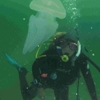General Description
Bell (body) lens-shaped, much thicker in the middle than at the edges. Numerous simple radial canals around the outside of the bell, with gonads extending along them. Large stomach in the centre, ringed by the radial canals. Numerous fine marginal tentacles. Usually colourless and transparent. Up to 1.8 m wide.
Biology
These jellyfish produce a fluorescent protein that has been used by many scientists in biomedical research. There are several species around Australia, however, they are difficult to differentiate.
Habitat
Open water, near surface to depth of 2000 m.
Open water
Distribution guide
Worldwide.
Species Group
Jellyfishes and allies › Jellyfishes
Depth
Shore (0-1 m)
Shallow (1-30 m)
Deep ( > 30 m)
Water Column
Max Size
1.5 m
Diet
Carnivore
Harmful
Not known to be dangerous to humans.
Commercial Species
No
Global Dispersal
Recorded in Australia
Identify
Conservation Status
- DSE Advisory List : Not listed
- EPBC Act 1999 : Not listed
- IUCN Red List : Not listed






